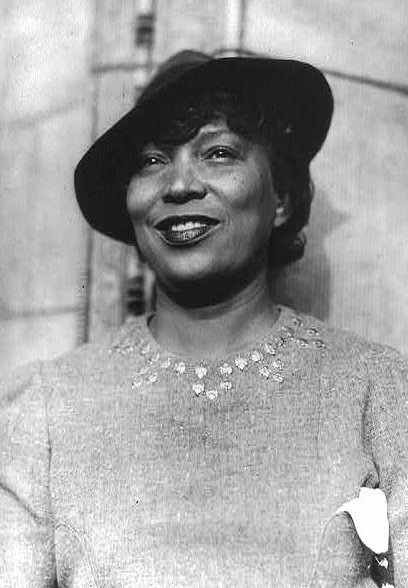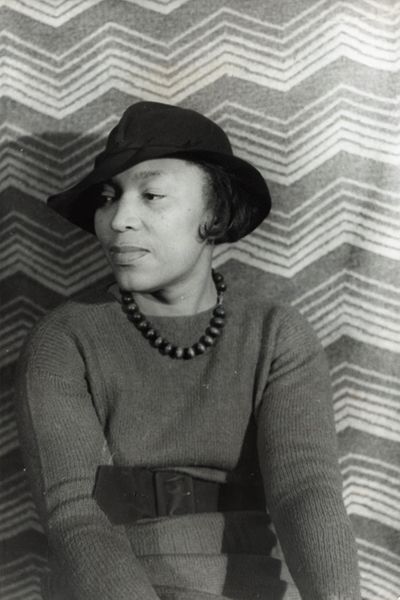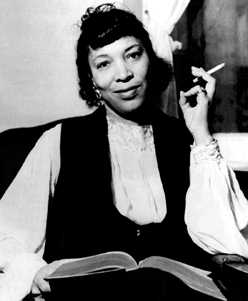<Back to Index>
- Folklorist and Writer Zora Neale Hurston, 1891
PAGE SPONSOR



Zora Neale Hurston (January 7, 1891 - January 28, 1960) was an American folklorist, anthropologist and author during the time of the Harlem Renaissance. Of Hurston's four novels and more than 50 published short stories, plays and essays, she is best known for her 1937 novel Their Eyes Were Watching God.
Hurston was the fifth of eight children of John Hurston and Lucy Ann Hurston (née Potts). Her father was a Baptist preacher, tenant farmer and carpenter, and her mother was a school teacher. She was born in Notasulga, Alabama, on January 7, 1891, where her father grew up and her grandfather was the preacher of a Baptist church. Her family moved to Eatonville, Florida, one of the first all - Black towns to be incorporated in the United States, when she was three. Hurston said she always felt that Eatonville was "home" to her and sometimes claimed it as her birthplace. Her father later became mayor of the town, which Hurston would glorify in her stories as a place where African Americans could live as they desired, independent of white society. In 1901, some northern schoolteachers visited Eatonville and gave Hurston a number of books that opened her mind to literature, and this may be why she sometimes describes her "birth" as taking place in that year. Hurston spent the remainder of her childhood in Eatonville, and describes the experience of growing up in Eatonville in her 1928 essay "How It Feels to Be Colored Me".
In 1904, Hurston's mother died and her father remarried, to Matte Moge, almost immediately, considered something of a minor scandal as it was rumored he had relations with Moge before Lucy died. Hurston's father and new stepmother sent her away to a boarding school in Jacksonville, Florida, but they eventually stopped paying her tuition and the school expelled her. She later worked as a maid to the lead singer in a traveling Gilbert & Sullivan theatrical company. In 1917, Hurston began attending Morgan Academy, the high school division of the historically African American Morgan College in Baltimore, Maryland. It was at this time, and apparently to qualify for a free high school education (as well, perhaps to reflect her literary birth), that the 26 year old Hurston began claiming 1901 as her date of birth. She graduated from Morgan Academy in 1918.
In 1918, Hurston began undergraduate studies at Howard University, where she became one of the earliest initiates of Zeta Phi Beta Sorority and co-founded The Hilltop, the University's student newspaper. While there, she took courses in Spanish, English, Greek and public speaking and earned an Associate's Degree in 1920. In 1921, she wrote a short story, John Redding Goes to Sea, which qualified her to become a member of Alaine Locke's literary club, The Stylus. Hurston left Howard in 1924 and in 1925 was offered a scholarship to Barnard College, Columbia University, where she was the college's sole black student. Hurston received her B.A. in anthropology in 1927, when she was 36. While she was at Barnard, she conducted ethnographic research with noted anthropologist Franz Boas of Columbia University. She also worked with Ruth Benedict as well as fellow anthropology student Margaret Mead. After graduating from Barnard, Hurston spent two years as a graduate student in anthropology at Columbia University.
In 1927, Hurston married Herbert Sheen, a jazz musician and former classmate at Howard who would later become a physician, but the marriage ended in 1931. In 1939, while Hurston was working for the WPA, she married Albert Price, a 23 year old fellow WPA employee, and 25 years her junior, but this marriage ended after only seven months.
She lived in a cottage in Eau Gallie, Florida, twice, once in 1929 and again in 1951.
During the 1930s, Hurston was a resident of Westfield, New Jersey, where Langston Hughes was among her neighbors.
In later life, in addition to continuing her literary career, Hurston served on the faculty of North Carolina College for Negroes (now North Carolina Central University) in Durham, North Carolina.
She also established, in 1934, a school of dramatic arts "based on pure Negro expression" at Bethune - Cookman University (at the time, Bethune - Cookman College) in Daytona Beach, FL. In 1956 Hurston was bestowed the Bethune - Cookman College Award for Education and Human Relations in recognition of her vast achievements, and the English Department at Bethune - Cookman College remains dedicated to preserving her cultural legacy.
Hurston traveled extensively in the Caribbean and the American South and immersed herself in local cultural practices to conduct her anthropological research. Her work in the South, sponsored from 1928 to 1932 by Charlotte Osgood Mason, a wealthy philanthropist, produced Mules and Men in 1935, often regarded as a folklore classic, as well as the base material for novels like Jonah's Gourd Vine published in 1934.
In 1936 and 1937, she traveled to Jamaica and to Haiti with support from the Guggenheim Foundation from which her anthropological work Tell My Horse published in 1938 emerged.
She also lived in Honduras, at the north coastal town of Puerto Cortés from October 1947 to February 1948. Her trip to Central America was apparently occasioned by the idea of locating either Mayan ruins or vestiges of some other as yet undiscovered civilization. While in Puerto Cortés, she wrote much of Seraph on the Suwanee, a book which had nothing to do with Honduras. Hurston expressed interest in the polyethnic nature of the population in the region (many of whom, such as the Miskito Zambu and Garifuna were in fact of partial African ancestry).
In 1948, Hurston was falsely accused of molesting a ten year old boy, and although the case was dismissed after Hurston presented evidence that she was in Honduras when the crime supposedly occurred in the U.S., her personal life was seriously disrupted by the scandal.
Hurston spent her last decade as a freelance writer for magazines and newspapers. Her autobiography reported that she worked in a library in Cape Canaveral, Florida; although new evidence indicates she worked at the Pan Am Technical Library at Patrick Air Force Base in 1957, just prior to moving to Fort Pierce. Here she took jobs where she could find them, including being a substitute teacher and a maid.
During a period of financial and medical difficulties, Hurston was forced to enter St. Lucie County Welfare Home, where she suffered a stroke; she died of hypertensive heart disease on January 28, 1960, and was buried at the Garden of Heavenly Rest in Fort Pierce, Florida. Her remains were in an unmarked grave until 1973, when novelist Alice Walker and literary scholar Charlotte Hunt found an unmarked grave in the general area where Hurston had been buried, and decided to mark it as hers.
When Hurston arrived in New York City in 1925, the Harlem Renaissance was at its peak, and she soon became one of the writers at its center. Shortly before she entered Barnard, Hurston's short story “Spunk” was selected for The New Negro, a landmark anthology of fiction, poetry and essays focusing on African and African American art and literature. In 1926, a group of young black writers including Hurston, Langston Hughes and Wallace Thurman, calling themselves the Niggerati, produced a literary magazine called Fire!! that featured many of the young artists and writers of the Harlem Renaissance. In 1929, Hurston moved to Eau Gallie in Florida where she wrote, "Mules and Men" which was later published in 1935.
By the mid 1930s, Hurston had published several short stories and the critically acclaimed Mules and Men (1935), a groundbreaking work of "literary anthropology" documenting African American folklore. In 1930, she also collaborated with Langston Hughes on Mule Bone: A Comedy of Negro Life in Three Acts, a play that was never finished, although it was published posthumously in 1991.
In 1937, Hurston was awarded a prestigious Guggenheim Fellowship to conduct ethnographic research in Jamaica and Haiti. Tell My Horse (1938) documents her account of her fieldwork studying African rituals in Jamaica and voudon rituals in Haiti. Hurston also translated her anthropological work into the performing arts, and her folk revue, The Great Day premiered at the John Golden Theatre in New York in 1932.
Hurston's first three novels were also published in the 1930s: Jonah's Gourd Vine (1934); Their Eyes Were Watching God (1937), written during her fieldwork in Haiti and considered her masterwork; and Moses, Man of the Mountain (1939).
In the 1940s, Hurston's work was published in such periodicals as The American Mercury and The Saturday Evening Post. Her last published novel, Seraph on the Suwanee, notable principally for its focus on white characters, was published in 1948. It explores images of 'white trash' women. Jackson argues that Hurston's meditation on abjection, waste, and the construction of class and gender identities among poor whites reflects the eugenics discourses of the 1920s.
In 1952, Hurston was assigned by the Pittsburgh Courier to cover the small town murder trial of Ruby McCollum, the prosperous black wife of the local bolita racketeer, who had killed a racist white doctor. She also contributed to Woman in the Suwannee County Jail, a book by journalist and civil rights advocate William Bradford Huie. In 2008, The Library of America selected excerpts from this work for inclusion in its two - century retrospective of American True Crime writing.
Hurston's work slid into obscurity for decades, for a number of cultural and political reasons.
Many readers objected to the representation of African American dialect in Hurston's novels, given the racially charged history of dialect fiction in American literature. Her stylistic choices in terms of dialogue were influenced by her academic experiences. Thinking like a folklorist, Hurston strove to represent speech patterns of the period which she documented through ethnographic research. For example, a character in Jonah's Gourd Vine expresses herself in this manner:
- "Dat's a big ole resurrection lie, Ned. Uh slew-foot, drag-leg lie at dat, and Ah dare yuh tuh hit me too. You know Ahm uh fightin' dawg and mah hide is worth money. Hit me if you dare! Ah'll wash yo' tub uh 'gator guts and dat quick."
Several of Hurston's literary contemporaries criticized Hurston's use of dialect as a caricature of African American culture rooted in a racist tradition. More recently, many critics have praised Hurston's skillful use of idiomatic speech. In particular, a number of writers associated with the Harlem Renaissance were critical of Hurston's later writings, on the basis that they did not agree with or further the position of the overall movement. One particular criticism came from Richard Wright in his review of Their Eyes Were Watching God:
- ... The sensory sweep of her novel carries no theme, no message, no thought. In the main, her novel is not addressed to the Negro, but to a white audience whose chauvinistic tastes she knows how to satisfy. She exploits that phase of Negro life which is "quaint," the phase which evokes a piteous smile on the lips of the "superior" race.
During the 1930s and 1940s when her work was published, the pre-eminent African American author was Richard Wright. Unlike Hurston, Wright wrote in explicitly political terms, as someone who had become disenchanted with communism, using the struggle of African Americans for respect and economic advancement as both the setting and the motivation for his work. Other popular African American authors of the time, such as Ralph Ellison, dealt with the same concerns as Wright. Hurston's work, which did not engage these political issues, did not fit in with this struggle. In 1951, for example, Hurston argued that New Deal economic support created a harmful dependency by African Americans on the government, and that this dependency ceded too much power to politicians.
An article, "In Search of Zora Neale Hurston", by Alice Walker, published in the March 1975 issue of Ms. magazine, revived interest in Hurston's work. The reemergence of her work coincided with the emergence of authors such as Toni Morrison, Maya Angelou and Walker herself, whose works are centered on African American experiences and include, but do not necessarily focus upon, racial struggle.
Biographies of Hurston include Zora Neale Hurston: A Literary Biography by Robert Hemenway; Wrapped in Rainbows by Valerie Boyd; Zora Neale Hurston: A Biography of the Spirit by Deborah G. Plant; "Zora Neale Hurston's Final Decade" by Virginia Lynn Moylan; and Speak So You Can Speak Again by Hurston's niece, Lucy Anne Hurston. Her hometown of Eatonville, Florida, celebrates her life in an annual festival.
In 2001, "Every Tongue Got to Confess" was published posthumously. The book was a collection of field materials Hurston had gathered in the late 1920s to create her book "Mules and Men". Originally titled "Folktales from the Gulf States", filmmaker Kristy Andersen had discovered the previously unknown collection of folk tales while researching the Smithsonian archives when they were placed in computer catalogs in 1997.
Hurston's house in Fort Pierce is a National Historic Landmark.
Fort Pierce celebrates Hurston annually through various events such as Hattitudes, birthday parties, and a several - day festival at the end of April known as Zora Fest. Her life and legacy are also celebrated every year in Eatonville, the town that inspired her, at the Zora Neale Hurston Festival of the Arts and Humanities.
In 2002, scholar Molefi Kete Asante listed Zora Neale Hurston on his list of 100 Greatest African Americans.
John McWhorter has called Hurston "America's favorite black conservative" while David T. Beito and Linda Royster Beito have argued that she can better be characterized as a "libertarian." She was a Republican who was generally sympathetic to the foreign policy non - interventionism of the Old Right and a fan of Booker T. Washington's self - help politics. She disagreed with the philosophies (including Communism and the New Deal) supported by many of her colleagues in the Harlem Renaissance, such as Langston Hughes, who was in the 1930s a supporter of the Soviet Union and praised it in several of his poems. Despite much common ground with the Old Right in domestic and foreign policy, Hurston was not a social conservative. Her writings show skepticism toward traditional religion and affinity for feminist individualism. In this respect, her views were similar to two libertarian novelists who were her contemporaries: Rose Wilder Lane and Isabel Paterson.
In 1952, Hurston supported the presidential campaign of Senator Robert A. Taft. Like Taft, Hurston was against Franklin D. Roosevelt's New Deal policies. She also shared his opposition to Roosevelt and Truman's interventionist foreign policy. In the original draft of her autobiography, Dust Tracks on a Road, Hurston compared the United States government to a "fence" in stolen goods and to a Mafia - like protection racket. Hurston thought it ironic that the same “people who claim that it is a noble thing to die for freedom and democracy ... wax frothy if anyone points out the inconsistency of their morals. ... We, too, consider machine gun bullets good laxatives for heathens who get constipated with toxic ideas about a country of their own.” She was scathing about those who sought "freedoms" for those abroad, but denied it to people in their home countries: Roosevelt "can call names across an ocean" for his Four Freedoms, but he did not have “the courage to speak even softly at home.” When Truman dropped the atomic bombs on Japan, she called him “the Butcher of Asia.”
Hurston opposed the Supreme Court ruling in the Brown v. Board of Education case of 1954. She felt that if separate schools were truly equal (and she believed that they were rapidly becoming so), educating black students in physical proximity to white students would not result in better education. In addition, she worried about the demise of black schools and black teachers as a way to pass on cultural tradition to future generations of African - Americans. She voiced this opposition in a letter, "Court Order Can't Make the Races Mix", that was published in the Orlando Sentinel in August 1955. Hurston had not reversed her long time opposition to segregation. Rather, she feared that the Court's ruling could become a precedent for an all - powerful federal government to undermine individual liberty on a broad range of issues in the future. Hurston also opposed preferential treatment for African - Americans, saying:
If I say a whole system must be upset for me to win, I am saying that I cannot sit in the game, and that safer rules must be made to give me a chance. I repudiate that. If others are in there, deal me a hand and let me see what I can make of it, even though I know some in there are dealing from the bottom and cheating like hell in other ways.
In 1989 PBS aired a drama based on Hurston's life titled Zora is My Name!.
The 2004 film Brother to Brother, set in part during the Harlem Renaissance, featured Hurston (portrayed by Aunjanue Ellis).
Their Eyes Were Watching God was adapted for a 2005 film of the same title by Oprah Winfrey's Harpo Productions, with a teleplay by Suzan - Lori Parks. The film starred Halle Berry as Janie Starks.
On April 9, 2008 PBS broadcast a 90 minute documentary Zora Neale Hurston: Jump at the Sun written and produced by filmmaker Kristy Andersen, as part of the American Masters series.
In 2009, Hurston was featured in a 90 minute documentary about the WPA Writers' Project titled Soul of a People: Writing America's Story, which premiered on the Smithsonian Channel. Her work in Florida during the 1930s is also highlighted in the companion book, Soul of a People: The WPA Writers' Project Uncovers Depression America